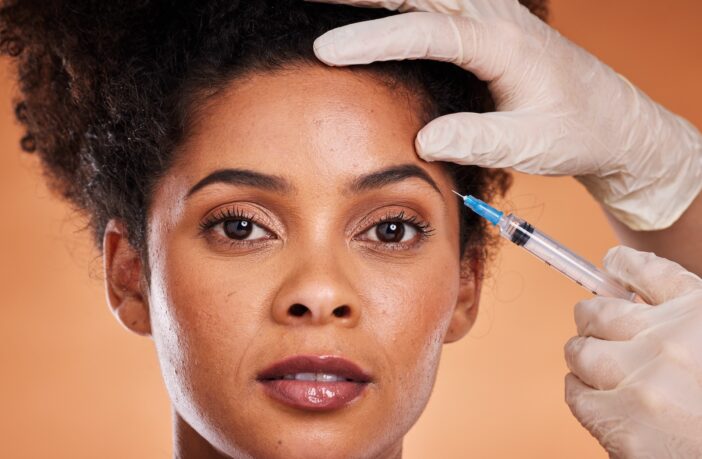We all know that “Black don’t crack.”
This and similar adages have given Black people a complex relationship with aging. It feels like we’re culturally programmed to reject anything labeled “anti-aging” or “wrinkle-reducing.” We think we don’t need it, believing we’re immune to societal pressures to slow down the physical signs of aging.
But that’s not true. Our perceived ability to avoid the global desire to look like we’re in our 20s forever has made us wary of words like Botox. Just mentioning injectables often leads to a chorus of objections, claiming that we don’t need them.
Beyond the assumption that cosmetic procedures are a necessity, there’s also a lack of awareness about botox’s uses beyond aesthetics. It’s been used for years to treat chronic ailments like TMJ, chronic migraines and Bell’s palsy.
The gap in marketing efforts has also contributed to this skepticism, as Black people have been largely ignored in advertising. This creates a range of misinformation.
If you’re curious about botox but unsure where to start, what to look for, or who to go to, we’ve outlined some essential information to help you navigate the world of neurotoxins.
Meet our expert:
Ginille Brown is a licensed cosmetic nurse practitioner with over 11 years of experience in aesthetic injections and treatments. She is the founder of Ginille Beauty Aesthetics, a Los Angeles-based aesthetics center specializing in services like Botox, microneedling, and fillers.
What is Botox?
Botox (botulinum toxin) is a brand-name neurotoxin that has become synonymous with many injectables serving the same purpose. Other common forms include Xeomin, Dysport, and Daxify. Neurotoxins work by immobilizing the muscles at the injection site, stopping the production of wrinkles.
“Botox is a non-surgical procedure. The injection is placed into your facial muscles to help relax the muscles from contracting,” Brown tells EBONY. Initial results can be seen within three to four days, with final results appearing around two weeks after the injection. “It usually lasts three to four months. Some people get a little bit longer or not as long. It depends on the dose and how their body metabolizes it,” Brown explains.
What can it be used for?
Botox is most commonly used to reduce the appearance and formation of wrinkles and fine lines. Common injection sites include crow’s feet, the forehead, and frown lines, but the specific placement is determined at the appointment based on individual needs.
“When we lift our eyebrows, those lines can start to get etched in over time. So some people like to smooth those out,” Brown says. The nostrils and upper lip are also growing areas of interest. “It can be used to prevent the nostrils from flaring and to prevent a lip from curling in when you smile, which can cause a gummy smile,” Brown adds. Botox can also help people with Bell’s palsy restore facial symmetry and reduce overactive muscles causing TMJ, teeth grinding, and chronic migraines.
“When people have headaches from clenching their teeth, grinding, or jaw pain, they may be flexing those muscles with too much force or clenching down in their sleep,” Brown explains.
Who should get it?
Brown emphasizes that cosmetic botox is not a necessity for anyone. “It’s the same as why someone would wear makeup or get their hair done. It’s a personal choice,” she says. Botox is a thoroughly researched and medically backed procedure that can be used for aesthetic reasons, but it is not essential. “I’ll have patients ask, ‘Do I need this?’ I tell them no. None of us ‘need’ it,” Brown says.
Who should avoid it?
Botox is generally safe for most people, but some individuals may not be good candidates. “I tell patients to check with their primary care physician or specialty doctor if they have any medical conditions,” Brown advises. Conditions that may make someone incompatible with botox include:
Myasthenia gravis
Lambert-Eaton syndrome
Amyotrophic lateral sclerosis (ALS)
Pregnancy or breastfeeding
Are there any risks?
Botox is considered a safe procedure and is FDA-approved. However, like any medical procedure, there are potential risks. “Risks can include bruising and swelling. If the placement is inappropriate, you might not get the desired cosmetic outcome,” Brown explains.
How to find the best injector:
Finding a reputable and safe provider is crucial. “If you can get a referral from someone you trust and like the way they look, that’s very helpful,” Brown says. Once you find a provider, do thorough research. “Check their reputation, read reviews, look at before and after photos from their patients, and read what their patients have said,” Brown advises.
“Read reviews on the facility and their background. Ensure that the person providing the services is appropriately qualified,” says Brown. In most states, the minimum requirement is at least a registered nurse. Some states have less stringent requirements, so it’s important to ensure the person is skilled and knows what they’re doing.



